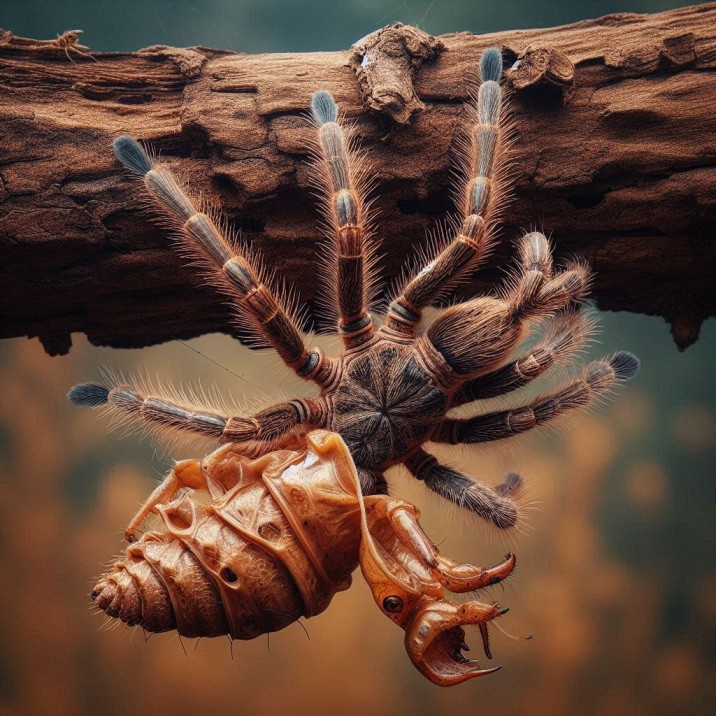Table of Contents
Table of Contents
- Introduction
- Understanding Tarantulas
- What Are Tarantulas?
- Why Do Tarantulas Shed Their Skin?
- The Molting Process
- How Do Tarantulas Shed Their Skin?
- Why Is Molting Important?
- Frequency of Molting
- How Often Do Tarantulas Shed Their Skin?
- Signs of Molting
- What Are the Signs That a Tarantula Is About to Molt?
- Caring for a Molting Tarantula
- How to Help a Molting Tarantula
- Interesting Facts About Tarantula Molting
- Table of Information
- FAQs
- Conclusion
Introduction
Have you ever wondered if tarantulas shed their skin? The process is fascinating and important for these eight-legged creatures. In this article, we will explore the world of tarantulas and answer the intriguing question: Do tarantulas shed their skin? We will also learn why they do it, how often it happens, and what it means for their survival.

Understanding Tarantulas
What Are Tarantulas?
Tarantulas are large spiders known for their hairy bodies and legs. They belong to the family Theraphosidae and are found in various parts of the world, including the United States, South America, and Africa. These spiders come in many colors and sizes, with some growing as large as a dinner plate!
- Appearance: Hairy, often large, and come in different colors.
- Habitat: Forests, deserts, grasslands.
- Diet: Insects, small animals.
Tarantulas are known for their calm behavior and unique way of defending themselves by kicking hairs from their abdomen to deter predators.
Why Do Tarantulas Shed Their Skin?
Tarantulas, like many other arthropods (a group of animals that includes insects, spiders, and crustaceans), must shed their skin to grow. This process is called molting. Tarantulas have a hard outer skeleton called an exoskeleton. As they grow, their exoskeleton does not expand, so they need to shed it to make room for a larger one.
- Molting: The process of shedding the exoskeleton.
- Exoskeleton: Hard outer shell that does not stretch.
- Growth: Tarantulas need a new exoskeleton to grow larger.
The Molting Process
How Do Tarantulas Shed Their Skin?
The process of molting in tarantulas is an incredible transformation that can take several hours to complete. Here is a step-by-step look at how it happens:
- Preparation: The tarantula stops eating a few days or even weeks before molting. It becomes less active and may appear sluggish.
- Splitting the Exoskeleton: The tarantula creates a split along the back of its old exoskeleton. This is often where the process begins.
- Wiggling Out: The tarantula slowly wiggles its way out of the old exoskeleton. This can be a long and tiring process.
- New Exoskeleton: After molting, the tarantula’s new exoskeleton is soft and vulnerable. It takes several hours to harden and provide protection.
Why Is Molting Important?
Molting is crucial for a tarantula’s survival and growth. Without molting, they would not be able to grow larger or repair any damage to their exoskeleton. It also allows them to replace old, worn-out parts, like fangs or legs.
- Growth: Essential for growing larger.
- Repair: Helps fix damaged parts.
- Renewal: Replaces old body parts.
Frequency of Molting
How Often Do Tarantulas Shed Their Skin?
The frequency of molting depends on the tarantula’s age and species. Younger tarantulas molt more frequently than adults. Here’s a general guideline:
- Young Tarantulas: Every few weeks to a few months.
- Adult Tarantulas: Once a year or even less frequently.
The time between molts is called the molting cycle. Younger tarantulas have shorter cycles because they are growing rapidly.
Signs of Molting
What Are the Signs That a Tarantula Is About to Molt?
There are several signs that a tarantula is preparing to molt:
- Refusal to Eat: The tarantula may stop eating a few days or weeks before molting.
- Lethargy: It may become less active and spend more time hiding.
- Dull Coloration: The tarantula’s colors may become dull and faded.
- Swollen Abdomen: The abdomen may appear larger than usual.
These signs indicate that the tarantula is getting ready to shed its old skin.
Caring for a Molting Tarantula
How to Help a Molting Tarantula
Caring for a tarantula during molting is important to ensure it has a safe and stress-free environment. Here are some tips:
- Provide a Safe Habitat: Make sure the tarantula’s enclosure is secure and free from hazards.
- Maintain Proper Humidity: Keep the humidity levels appropriate for the species, as this helps the tarantula shed its skin more easily.
- Avoid Handling: Do not disturb or handle the tarantula during this time, as it is very vulnerable.
- Offer Fresh Water: Ensure that clean water is always available.
Providing the right care will help your tarantula molt successfully and stay healthy.
Interesting Facts About Tarantula Molting
Cool Facts You Might Not Know
- Regeneration: Tarantulas can regrow lost legs during the molting process.
- Multiple Layers: The old exoskeleton often looks like a perfect replica of the tarantula.
- Exuviae: The shed exoskeleton is called exuviae, which collectors often keep as a souvenir.
- Growth Spurts: After molting, tarantulas may experience rapid growth.
These facts show just how amazing the molting process is for tarantulas!
Table of Information
| Topic | Details |
|---|---|
| Molting Process | Tarantulas shed their old exoskeleton to grow. |
| Frequency | Young: Every few weeks/months. Adults: Once a year. |
| Signs of Molting | Refusal to eat, lethargy, dull coloration, swollen abdomen. |
| Care During Molting | Provide a safe habitat, maintain humidity, avoid handling. |
| Interesting Facts | Regeneration, multiple layers, exuviae, growth spurts. |
Conclusion
Tarantulas are fascinating creatures with unique behaviors, and their molting process is a remarkable example of nature’s wonders. By understanding how and why tarantulas shed their skin, we gain insight into their growth and survival. For young readers and animal enthusiasts in the USA, learning about tarantulas and their molting process can spark a lifelong interest in these incredible spiders.
FAQs
- Why do tarantulas shed their skin?
- Tarantulas shed their skin to grow larger and repair any damage to their exoskeleton.
- How often do tarantulas molt?
- Young tarantulas molt every few weeks to months, while adults molt about once a year.
- What are the signs that a tarantula is about to molt?
- Signs include refusal to eat, lethargy, dull coloration, and a swollen abdomen.
- Can tarantulas regrow lost legs during molting?
- Yes, tarantulas can regenerate lost legs during the molting process.
- How can I help my tarantula during molting?
- Provide a safe environment, maintain proper humidity, avoid handling, and offer fresh water.

